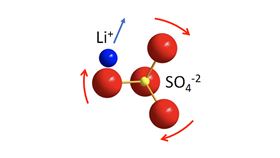 This illustration shows the paddlewheel effect. Above a certain temperature, sulfate anions in the solid electrolyte begin to rotate, causing nearby lithium cations to become highly mobile. Image: Argonne National Laboratory.
This illustration shows the paddlewheel effect. Above a certain temperature, sulfate anions in the solid electrolyte begin to rotate, causing nearby lithium cations to become highly mobile. Image: Argonne National Laboratory.Electricity storage in batteries is in ever increasing demand for smartphones, laptops, cars and the power grid. Solid-state batteries are among the most promising next-generation technologies because they offer a higher level of safety and potentially longer life.
The Joint Center for Energy Storage Research (JCESR), an Energy Innovation Hub led by the US Department of Energy (DOE)’s Argonne National Laboratory, has made significant strides with solid-state batteries as successors to today's lithium-ion (Li-ion) batteries. A major challenge with solid-state batteries is increasing the diffusivity of lithium ions in the solid-state electrolyte, as this diffusivity is typically slower than in the liquid organic electrolytes used in conventional Li-ion batteries.
JCESR's Linda Nazar, a leading professor at the University of Waterloo in Canada, one of JCESR's 18 partners, and Zhizhen Zhang, her postdoctoral research associate, have now shown how the mobility of lithium ions in solid-state batteries can be enhanced using the paddlewheel effect, which is the coordinated motion of atoms. They report their work in a paper in Matter.
According to Nazar, solid-state batteries, using solid electrolytes in place of the usual liquid organic electrolytes, have emerged as promising replacements for today's Li-ion batteries.
"They offer the potential of safer and longer-lasting batteries that can deliver the higher energy density important to a wide variety of electrochemical energy storage applications, such as vehicles, robots, drones and more," said Nazar. "As the most important component in solid-state batteries, the solid electrolyte determines its safety and cycle stability to a large extent."
An unwanted chemical reaction, called the thermal runaway reaction, has led to fires and explosions involving today's Li-ion batteries, which continue to burn until they run out of fuel. Because of these hazards, JCESR seeks to eliminate the internal liquid organic electrolyte by replacing it with a solid electrolyte.
Only a few solid-state electrolytes have ion conductivity as high as liquid organic electrolytes, and they tend to receive the lion's share of attention. But JCESR is exploring a promising phenomenon that can dramatically speed up ion diffusion: the rotational motion of normally static negative ions (i.e. anions) in the solid-state electrolyte framework that can help drive the motion of the positive lithium ions (i.e. cations).
"In fact, it turns out that the anion 'building blocks' that comprise the solid framework are not rigid, but undergo rotational motion," said Nazar. "Our study addresses this principle to show that anion dynamics in the framework of the solid enhance Li+ cation transport. The anion dynamics can be 'turned on' even at room temperature by tuning the framework, and the anion dynamics are strongly coupled to cation diffusion by the paddlewheel effect. This is somewhat akin to the transport of people through a multi-person revolving door."
While new solid electrolytes are still in the developmental stage, the advances are encouraging. A breakthrough would be a game changer and dramatically increase the safety and deployment of Li-ion batteries, according to JCESR director George Crabtree.
"If you can find a solid-state electrolyte enabling fast Li+ cation motion, it would be a drop-in replacement for liquid organic electrolytes and immediately rid batteries of the thermal runaway reaction, the major cause of fire in today's Li-ion batteries." said Crabtree. "For its safety advantages alone, there would be a huge market for it in cell phones, laptops, video recorders, autos and the electricity grid."
The intellectual enthusiasm for solid-state batteries is shared across JCESR. Other collaborators at the University of Michigan and Massachusetts Institute of Technology are also exploring solid electrolytes and the paddlewheel effect. Solid-state batteries are one of the most promising and sought-after advances for industry, said Crabtree.
"JCESR wants to understand the atomic and molecular level origins of battery behavior. With this knowledge, we can build the battery from the bottom up, atom-by-atom and molecule-by-molecule, where every atom and molecule play a prescribed role in producing the targeted battery behavior," Crabtree said. "The paddlewheel effect is an example of that. This paper is at the very frontier of solid electrolyte behavior, and we want to transfer this knowledge to the commercial sector."
This story is adapted from material from Argonne National Laboratory, with editorial changes made by Materials Today. The views expressed in this article do not necessarily represent those of Elsevier. Link to original source.